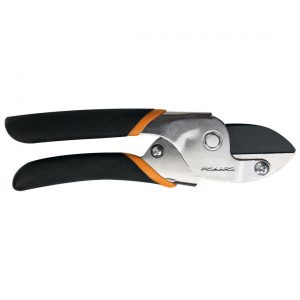 It’s springtime again, the frost is abating and the birds are out and chirping. The cool of winter has left and with it comes the possibilities and excitement for the summer months to come. All of the blooms that will soon be out and the grass that will be turning greener unfortunately wont do it on it’s own and needs a little attention to get that spring garden blossoming. We would all love a garden that transitions from winter to spring without us having to lay a finger but that is not the way of the suburban backyard! They require our attention and love if our plants are to flourish. So to make the most of your spring garden it’s good to be equipped with the right tools. If you walk into a gardening center chances you will be all too quickly overwhelmed with choice. There is an appliance and piece of equipment for everything these days, no matter how simple, and cruising down the isles it can be hard to know what you really need and what is just a cheap gimmick or trend that will end up doing more time hanging on your garden shed wall that actually being useful. That’s why we’ve put together a list of the essentials of your spring gardening and maintenance. Discover what you will suit you and your garden style.
It’s springtime again, the frost is abating and the birds are out and chirping. The cool of winter has left and with it comes the possibilities and excitement for the summer months to come. All of the blooms that will soon be out and the grass that will be turning greener unfortunately wont do it on it’s own and needs a little attention to get that spring garden blossoming. We would all love a garden that transitions from winter to spring without us having to lay a finger but that is not the way of the suburban backyard! They require our attention and love if our plants are to flourish. So to make the most of your spring garden it’s good to be equipped with the right tools. If you walk into a gardening center chances you will be all too quickly overwhelmed with choice. There is an appliance and piece of equipment for everything these days, no matter how simple, and cruising down the isles it can be hard to know what you really need and what is just a cheap gimmick or trend that will end up doing more time hanging on your garden shed wall that actually being useful. That’s why we’ve put together a list of the essentials of your spring gardening and maintenance. Discover what you will suit you and your garden style.
Shovels
There a quite a few types of shovels around, and with a lot of choice it can get confusing. With trenching shovels, drain shovels, scoop shovels, scrapers, edger’s and post-hole diggers it’s enough to have you mind swimming. So we’ve narrowed it down to the types of shovels you will actually use on a day-to-day basis for reclaiming your spring garden.
Here are the kinds of shovel you’re most likely to use when doing light work and light work around your garden.
Square Shovel
The square shovel is made for digging in harder soils. With its sharp tip and flat scoop Its ideal for moving soil around, getting loads of gravel and scooping and distributing fertilizer and mulch
Spade
A spade is usually shorter handled than it’s cousin the square shovel. They have sharp edges that are perfect for cutting into lawn or earth to make holes that you can plant in. This works best when they are kept sharp to it’s good to have some sharpening tools in your shed and keep an eye out for a dull edge.
Pointed Digger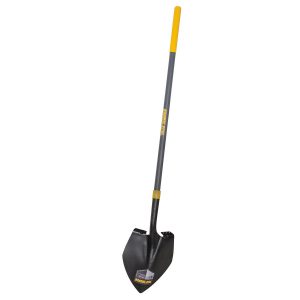
The pointed digger has a pointed tip that you would use if your soil was slightly more rock filled. The advantage of having a narrower tip means being able to dig a bit deeper and cut through the rockier soil with ease.
Round Digger
With it’s rounded tip, the round digger is perfect for soft soil and a great companion when wanted to transplant plants. Because of the way your force is transferred though digging, these allow you to drive into the ground a little easier than your regular square shovel.
Pruners
Pruning back your plants every year is essential to cut away the dead or straggling limbs and allow the plant to give more strength to new young branches and allow them to thrive. Many plants will suffer greatly if not pruned annually or even bi annually. This is an important job but like with a lot of gardening tasks can be time consuming and while not physically labor intensive can still cause some stress to your fingers hands and arms so choosing the right pruners for the job you are doing and also ones that will be comfortable and fit your hand shape right is of up most importance. Here are the three main pruning types you will use in your home garden.
Anvil Pruners
Anvil Pruners have a straight single blade that has a splitting action that will cut down directly on a branch or stem of a plant.
Ratchet Pruners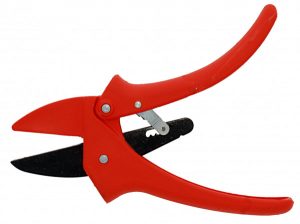
These are similar to the anvil, their main point of difference being that they cut in stages due to a different mechanism. Often used by people who have more sensitive wrists and are worried about over straining or damaging their joints.
Bypass Pruners
The bypass pruners are more like scissors but with curved blades. These make nice clean cuts when used correctly and are most often used when pruning green stems.
Gloves
Some people love the feel of the earth on their hands while they are planning and growing, but for others spending hours scrubbing out dirt from under their nails is not all that appealing. Gardening gloves are not only for protecting the superficial however and can be a great tool that makes handling rougher and thorned plants a lot easier. With a few sorts to choose from we show you the most used gloves and their uses so you can make the decision that is best for the work you will be doing in them.
Cloth Gloves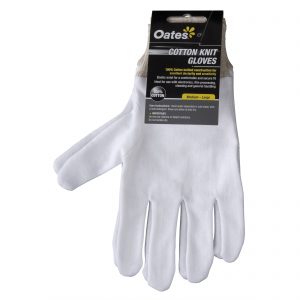
Cloth gloves are mostly made of cotton. These are the kind of gloves you would use for doing your light planting, mixing in your soil by hand and also as a light protection while using shovels or rakes. Some cloth gloves can be reinforced with leather patches to make them a bit hardier, but on the whole they are not a durable glove and as they are inexpensive will need to be replaced a bit more often.
Leather Gloves
Softer leather gloves made from sheep or goatskin are the ideal for a long day planning of digging in the back yard. They are far more durable than the cloth so invest in a pair that are comfortable and will wear in nicely. These gloves are great at keeping moister off your hands and being a protection against light thorns and brambles. But if you are planning on doing a lot heavier and abrasive work then you should consider some tougher cowhide or pigskin gloves.
Rubber and PVC-Coated Gloves
These gloves are great to use as protection against spiky plants and are also good if you will be working in a muddy area as the damp wont soak through and it easier to wash off than it’s leather counterpart. You can also get these gloves in a longer length so you can get right into your prickly bushes without cutting up your arms.
When buying gloves make sure to first try them on to test the size and comfort factors. There’s nothing worse than feeling uncomfortable in the garden all day long.
Hoses 
It may sound obvious but a good hose is an essential and with hoses there can be more than meets the eye. Choosing a good hose in not only about length, width and durability but also about the attachments and nozzles you use that will suit your style of garden.
There’s a few things you need to consider before purchasing your garden hose; length, width and material. Bellow we give you the run down.
Hose Length
You don’t always want the longest hose you can find, long hoses can end up getting a lot more kinks and are harder to store. Take some measurements of your property and see how much area you will have to cover to make sure your hose stretched just the right amount, then make your calculations from there.
Hose Width
The width is to do with the volume of water you will want coming out the end at the one time. If you have mainly flowers and herbs in your garden you are not going to want a big thick hose but instead a thinner one so you don’t flood your plants. But if it’s a lot of trees or thicker rooted plants in harder soil you need to get water too then a wider hose will be for you.
Hose Material
Most hoses are made from vinyl or rubber or can be a combination of both, here are the advantages and disadvantages.
Vinyl Hose
Vinyl hoses are the cheapest option and also the most lightweight which can be an advantage for some. But with that also comes a less durable item that kinks more easily and can crack if left out in the sun for too long. If you only have a small garden and not a whole lot of space then a vinyl hose can be a good alternative for you.
Rubber Hose
These are the stronger hose by far but with that strength comes a heavier model and a bigger price tag. The rubber hose can handle hot water better and so can be better for hot climates where the water heats under the ground. These will not kind as easily as the vinyl also and in general are just a sturdier hose.
Reinforced Hose
A reinforced hose had a mesh lining between its layers of rubber and vinyl and are praised for being able to handle high water pressure levels and have a better resistance to kinking and splitting. But don’t be fooled by thinking that extra layers means strength, rubber hoses are still generally the stronger option.
When buying a rubber or vinyl hose remember that they can leach some chemicals into the water through time so it is best not to drink from them of fill your pets bowls with water from them. There are other chemical free options if this is a big concern for you.
Hose Nozzles
Once you’ve picked the right hose type for you, take a look again at what function you will want your hose to preform. Do you want a high pressure sprayed for your car or boat as well as your plants or do you only want a gentle mister? A lot of nozzles come with a few different settings and some even come with locking mechanisms, which can be perfect if you have young one who don’t understand about saving on water!
Traditional Straight Nozzle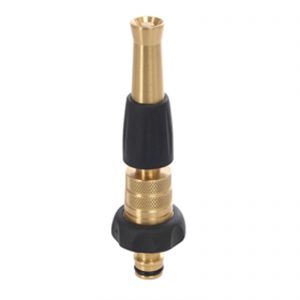
The Traditional Nozzle is a straight nozzle made from either metal or plastic that uses a twist function to allow more and less water through. Twisted fully in one direction it will release a hard straight spray style and then back the other back it will seem to be completely turned off. This is great if you want more of a directional spray, just be aware when turning twisting it off to not keep the hose running for too long or the build up of water pressure can sometime take the nozzle off completely.
Pistol Grip Nozzle
This nozzle is shaped to be held; yep you guessed it, like a pistol, applying pressure with your hand will turn it on. These nozzles often have a few different setting from a hard stream to a fine mist and then with their round shape can also produce a watering can like flow. These are great for watering flowers and fragile plants and covering a larger area at once.
Fan Nozzle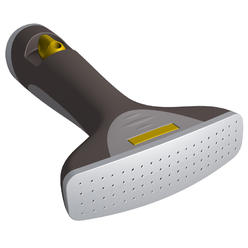
The fan nozzle spread’s it’s water out in a flatter fan shape and usually has only one spray setting. This kind of attachment is best used to cover large areas and is perfect for new lawns or dampening soil after seeding. The flow is often more gentle with the fan nozzle so you don’t have to worry about damaging plants with a heavy flow.
Get Into Spring!
With so many amazing tools out there to help you with your spring garden there really is no excuse not to get out into the yard and start reclaiming the beauty of your outdoor space.



